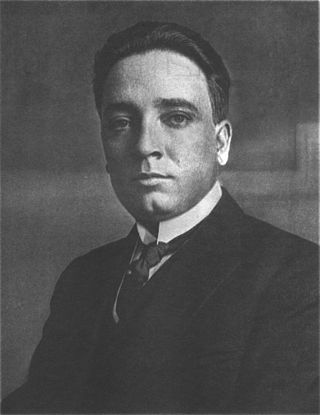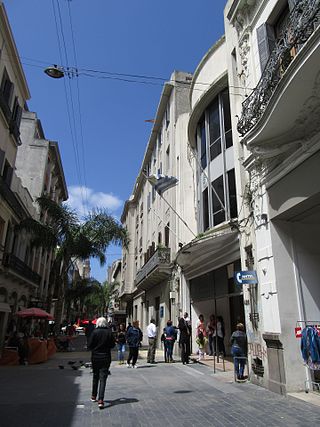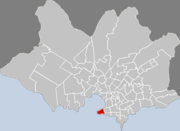
Montevideo is the capital and largest city of Uruguay. According to the 2011 census, the city proper has a population of 1,319,108 in an area of 201 square kilometers (78 sq mi). Montevideo is situated on the southern coast of the country, on the northeastern bank of the Río de la Plata.

The President of Colombia is the head of state and head of government of the Republic of Colombia. The president heads the executive branch of the national government and is the commander-in-chief of the Military Forces of Colombia.

The Pemex Executive Tower is a skyscraper in Mexico City. The 211-metre (692 ft) international style tower was built between 1979 and 1984. Since the building's opening, it has been occupied by state-owned Pemex, one of the largest petroleum companies in the world.

Palacio Salvo is a building at the intersection of 18 de Julio Avenue and Plaza Independencia in Montevideo, Uruguay. It was designed by the architect Mario Palanti, an Italian immigrant living in Buenos Aires, who used a similar design for his Palacio Barolo in Buenos Aires, Argentina. Finished in 1928, Palacio Salvo stands 100 m (330 ft) high with the antenna included. It was the tallest building in Latin America for a brief period.

The Palácio do Planalto in Brasília is the official workplace of the president of Brazil. The building was designed by Oscar Niemeyer in 1958 and inaugurated on 21 April 1960. It has been the workplace of every Brazilian president since Juscelino Kubitschek. It is located at the Praça dos Três Poderes, to the east of the National Congress of Brazil and across from the Supreme Federal Court.

Baltasar Brum Rodríguez, GCTE was a Uruguayan political figure. He was President of Uruguay from 1919 to 1923.

Centro is a barrio of Montevideo, Uruguay. Its main axis is 18 de Julio Avenue, and it runs between Plaza Independencia and Ejido St, being the central business district.

Solís Theatre is Uruguay's most important and renowned theater. It opened in 1856. The building was designed by the Italian architect Carlo Zucchi. It is located in Montevideo's Old Town, right next to the Plaza Independencia. The theatre was named after the explorer Juan Díaz de Solís, who was the first European explorer to land in modern day Uruguay.

Plaza Independencia is the most important city square in Montevideo, Uruguay, laid out in the 19th century in the area occupied by the Citadel of Montevideo. In its center is a monument to General José Gervasio Artigas, and below it, his mausoleum.

Avenida 18 de Julio, or 18 de Julio Avenue, is the most important avenue in Montevideo, Uruguay. It is named after the date when the country's first Constitution was sworn in, on July 18, 1830.

The Estévez Palace is a building situated in Plaza Independencia, Montevideo, Uruguay, designed in a combination of Doric and Colonial styles by Manoel de Castel in 1873. It has served as the working place of the President of Uruguay and has been eventually converted to a museum, housing artifacts and mementos of the Uruguayan presidency and its office holders.

Liberty Building served as one of two executive office buildings of the President of Uruguay.

The Legislative Palace of Uruguay is a monumental building, meeting place of the General Assembly of Uruguay, and the seat of the legislative branch of the Uruguayan government. It is located in the Aguada neighborhood of Montevideo.

Carlos Adolfo Ott is a Uruguayan-Canadian architect. He became famous when he won the international design competition in 1983 for the construction of the Opéra Bastille in Paris, which was inaugurated on July 14, 1989. Starting from an office in Toronto, Canada, Ott has since expanded his practice internationally. Ott's practice is headquartered in Montevideo, Uruguay, with offices in Dubai, Montreal, Shanghai and Toronto. Ott has designed buildings in Argentina, Canada, China, France, Germany, India, Paraguay, The Philippines, Singapore, Switzerland, United Arab Emirates, the United States, and Uruguay.
Claudia Turbay Quintero is a Colombian journalist and diplomat. She has served as Ambassador of Colombia to Switzerland, with dual accreditation as Non-Resident Ambassador to Liechtenstein, Ambassador of Colombia to Uruguay with dual accreditation as Permanent Representative of Colombia to the Latin American Integration Association in Montevideo, and had over 27 years of experience working with Proexport, holding various positions including Commercial Director in the Miami offices, and Vice President, eventually being appointed President of the agency in 2002.

Libertador Avenue is a major avenue in Montevideo, Uruguay. It stretches north from the Legislative Palace in Aguada to Plaza Fabini in Centro, and is named after Juan Antonio Lavalleja, revolutionary figure and politician, who led the group of the Thirty-Three Orientals in the insurrection for the independence of Oriental Province.

Peatonal Sarandí is an 0.5 miles pedestrian street in Ciudad Vieja, Montevideo, Uruguay. It is the main lane of the historic center, and one of the most touristic sites in the city, due to the fact that it is flanked by different architecturally notable buildings. The pedestrian street starts at the Gateway of the Citadel and ends at its intersection with Peatonal Pérez Castellano, while the remaining four blocks, up to the Rambla, are allowed for vehicles. As an extension of this street is the long southern breakwater of the Port of Montevideo, which has taken on the name "Escollera Sarandí".

The Piria Palace is the headquarters of the Supreme Court of Uruguay. Located on the south side of the Plaza de Cagancha in Montevideo, on the Human Rights Passage, it was declared a National Historical Monument in 1975. In front of its main entrance is the Monument to Justice, a work by Rafael Lorente Mourelle.
The following is a timeline of the history of the city of Montevideo, Uruguay.

Gaucho Tower is a high-rise commercial and office building in the Cordón neighborhood of Montevideo, Uruguay.






















